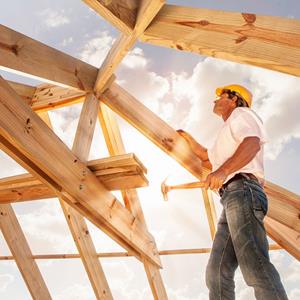
© Shutterstock/ Sculpies
The costs of building a new house can quickly add up to exceed your budget, making the decision to break ground on a new home build more stressful than exciting.
“There are three main factors when building a new home: budget, time and quality,” says architect Ibrahim Greenidge of BOLT Architecture in Brooklyn, N.Y. “To prioritize the budget consideration, leverage time and quality by being creative and flexible.”
Here are some real-life tips to keep costs in check while maximizing safety and quality, so you end up with the home of your dreams without breaking the bank.
Invest in Complete Plans
“It is critically important to come up with a plan first, before you hire contractors,” says Tom Kraeutler, host of The Money Pit podcast. “Changes are one of the most expensive unforeseen budget busters. So if you want to save money and have your house come out exactly how you want it to be, you need to invest in plans that you can commit to.”
Plans not only help you avoid expensive and time-consuming mistakes and changes during construction, they also give you a point of reference for soliciting contractor bids.
“A complete set of plans with detailed specifications gets you to an ‘apples to apples’ place when evaluating competing bids, making it easy to figure out which builder is actually offering the best overall price,” Kraeutler says.
Consider Downsizing
The cost of building a house has risen sharply over the past year, driven in large part by the steep rise in materials prices. Bigger houses are more expensive to build, so one simple way to maximize your budget is by limiting the size of your home. Home sizes have been trending down for years, and the average square footage is currently the smallest since 2011.
Greenidge suggests an open floor plan to make smaller interiors seem more ample. “A free-flowing design that moves seamlessly from the kitchen to the living room allows for multiple functions and a feeling of limitless space,” he says. Open plans also limit extra costs associated with interior walls, doors, hallways, wiring and plumbing.
Go Industrial
There’s a reason starving artists live in stripped-down lofts: money. This rustic industrial style is an excellent way to create a modern, edgy vibe while saving a significant amount on interior and exterior finishings. To create an aesthetic that looks purposefully rough and not simply unfinished, hire an able architect to draw up plans that are budget-conscious but livable.
Industrial design touches that are low-cost and functional include dyed concrete flooring, exposed beams or cinder blocks, metal windows and unfinished wood. This style especially lends itself to using repurposed materials.
“Many companies resell old building materials from teardowns and decommissioned buildings,” says general contractor Tim Bakke from The Plan Collection. “You may find all kinds of perfectly good materials you can use at less cost than new.”
Vet Your Contractor
“Successful project management is essential for staying on budget when building a house,” Bakke says. “Work with a reputable builder with a solid track record on completing homes of similar design and budget.”
Compare multiple bids, seek out references and be flexible about timing if the top contractors in your area can’t start your house build right away. Waiting a few months for a reliable, affordable contractor will save you more time and money in the long run than going with a more expensive and less trustworthy alternative who happens to be available now.
Repurpose Materials
With the price of framing lumber at an all-time high, repurposing or reclaiming wood as a building or finishing material has become one of the most significant ways to keep building costs down.
“Using reclaimed lumber can also be highly cost-effective,” says Kraeutler. “But be careful to buy your reclaimed lumber from a reputable supplier, because it’s important that any wood has been properly processed and treated.”
Other repurposed materials include stone or brick for interior and exterior finishings. “Used brick can be an attractive option for fireplace hearths, accent walls, porch steps or walkways,” Bakke says.
Source Your Finishings
Your contractor may not have the time or desire to comparison shop for the best prices on things like interior finishings, appliances or even windows and doors.
Although professionals can often get better prices on bulk items like framing lumber and exterior paint, with some careful sleuthing and comparison shopping, you can hunt down one-off bargains for big-ticket finishings and even snag high-quality, name-brand treasures at discounted prices.
General contractor and real estate broker Janie Coffey at The Coffey Team — Compass suggests scouring Facebook Marketplace and Craigslist; using second-hand sites like Renovation Angel that sell items pulled out of homes during renovation; contacting flippers and contractors who might let you take or pull out things on homes they are renovating; shopping at “scratch and dent” stores; and buying floor models of appliances.
DIY Where Possible (and Practical)
Labor is another significant budget line item for any new home construction, so taking a DIY approach to some parts of the build can help cap costs. “Some jobs are labor-intensive but not necessarily skill-intensive,” Bakke says. “If you are physically able and have a gung-ho mindset, then some work may be worth doing yourself.”
He lists wall sheathing and insulation with batting, installing drywall, plywood floor decking and wood flooring as jobs a handy DIYer could take on. “When it comes to those jobs requiring significant training or skills, we recommend leaving those for the experts,” he says.
Not all home builds allow for a DIY element, however. “Generally speaking, if you are an owner-builder — so you are the general contractor for the home build (the “boss” so to speak) — you can do much of the work yourself if have the proper insurance in place, including liability and builders’ risk insurance,” Bakke says.
But when working with a general contractor, Bakke says, be honest about your ability and make sure the contractor supports your involvement. “Many contractors don’t or would rather not allow a homeowner to participate for liability and workflow reasons,” he says.
Make Long-Term Investments
Spending more upfront in some areas will save you significant money down the road. Bakke says appliances and fixtures, mechanicals like heating and air-conditioning, kitchen cabinetry, flooring (especially in well-trafficked areas) and windows and doors are good long-term investments. Kraeutler also strongly recommends investing in the energy efficiency of your home, for increased comfort, lower utility bills and added value.
“For example, between fiberglass insulation or the more expensive spray foam, always spring for the spray foam,” Kraeutler says. “It’s a much better insulator, it seals and insulates at the same time and your return on investment will more than justify the higher initial cost.”
Don’t Forget Hidden Costs
Every home build budget has that mysterious “other” category among the line items which can add thousands to your final cost. Go over your budget carefully with your contractor or a trusted residential building expert to make sure you have covered all the major expenditures so your “other” category doesn’t grow so large that it derails your project.
Bakke says costs many home-build newbies overlook can run from excavation issues to accommodate a foundation to equipment rental expenses to local building code requirements.





